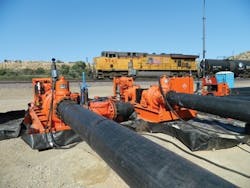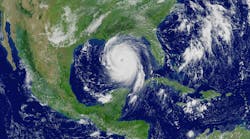Situated in the Mojave Desert, northeast of Los Angeles and southwest of Las Vegas, Victor Valley sits along the Interstate 15 corridor, in the high desert of Southern California. When five consecutive storms came rushing through the area in a short period of time in December 2010, flash floods ran rampant and local water and sewer infrastructure was put to the test.
Average rainfall in Victor Valley is approximately 5 in. The recurring storms in 2010 dropped more than 5 in. of rain in a seven-day period. This rainfall unleashed a chain of events that overwhelmed systems and wreaked havoc throughout the area.
The Mojave River, pushed to its limits, gushed at more than 36 cu ft per second in the Upper Mojave Narrows. The main sewer interceptor beneath the river became dislodged, causing raw sewage to spill over its banks and onto the Mojave Desert. It was an environmental catastrophe, declared a federal emergency by the Federal Emergency Management Agency, and needed immediate attention. Only now, more than five years later, is the Upper Narrows Pipeline Replacement Project in the final stages of completion, wrapping up repairs and improvements as a result of those catastrophic December rains.
First Things First
The Victor Valley Wastewater Reclamation Authority (VVWRA) serves nearly 400,000 people and treats more than 12 million gal of wastewater per day. It has been recognized in the industry for its wastewater treatment and renewable energy efforts.
In December 2010, when the river overflowed its banks, VVWRA called in the local team at Xylem to address the immediate need: get a temporary bypass in place as quickly as possible.
Xylem was on site first thing the following morning, with the equipment and personnel necessary to get the project started. After a quick assessment, pumps, piping and corresponding accessories were mobilized on the job site. Working 24/7, the complete bypass was designed and the team was able to stop the flow of raw sewage nine days later.
“We had to mobilize 5,000 ft of HDPE pipe from Colorado, over 500 miles away,” said Logan Olds, general manager of VVWRA. “Once it got here, we then had to fuse the pipe, build the bridge across the Mojave River and install the two pumping stations. Our vendor partners came through for us in a big way; nine days was nothing short of miraculous.”
The river bottom returned to normal within one hour of completing and implementing the bypass, and VVWRA was able to buy some time to figure out a permanent solution.
Two Projects in One
The Upper Narrows bypass essentially is composed of two distinct components. On the Victorville side of the project, there was a 36-in. sewer main with
7 million gal per day (mgd) of flow that had to be bypassed. The Xylem team brought in two Godwin Dri-Prime CD400M diesel drive pump sets pushing into a 21-in. HDPE discharge line that ran for nearly 1 mile. One pump could handle the 7 mgd of flow, so the second pump was a redundant mechanical backup.
Because the 21-in. discharge line ran along the Burlington Northern Santa Fe railroad tracks (the original California Southern line), crews had to balance getting the bypass installed and keeping the tracks clear for ongoing train activity.
On the Apple Valley side of the river, there was an 18-in. line that carried 3 mgd of flow to be bypassed. The pump chosen for the job was a Godwin Dri-Prime CD225M diesel drive pump set that discharged into a 16-in. HDPE line that ran for approximately 0.5 mile.
The pump could handle the 3 mgd of flow, but a second one was brought in as a redundant mechanical backup for this part of the bypass. Because the 16-in. line had to traverse back across the Mojave River, VVWRA brought in Apple Valley Construction and McBratney Co. to build a bridge across the river to support the 16-in. HDPE discharge.
Both temporary bypass lines dumped back into the force main to the treatment plant, and both were set up with level transducers to automatically trigger the backup pump sets at predetermined fluid levels. This precaution, as well as the redundant backup pumps, provided peace of mind for the VVWRA teams, who were concerned about the environmental impact of the project.
Equally challenging for both discharge lines were the natural, historic and environmental obstacles that had to be circumvented and addressed. From train tracks to ancient burial grounds, the teams had their hands full getting the piping where it needed to go.
Short Term to Long Term
What began as a quick temporary bypass to immediately address the sewage in the Mojave Desert turned into a long-term engagement. Over the course of the five-year project Xylem personnel were on site every 10 days, to service all four pumps—from basic oil changes to troubleshooting any issues. The bypass project also benefited from 24-hour pump watch to ensure everything was running smoothly. Having personnel on site around the clock is another component of the project that provided peace of mind to VVWRA.
“We are grateful for the efforts of the Xylem team on this entire project," Olds said. "Teams have been on site from day one, as soon as it happened, and they’ve been a great partner ever since. Their industry expertise and professionalism over the past five years has been a tremendous asset to me and to the rest of the VVWRA team.”
Little did anyone know back in 2010 that it would be a five-year journey from temporary bypass to complete system redesign and overhaul, working with engineers and construction teams to build a permanent sewer line that would avoid environmentally sensitive areas in the Upper Narrows. VVWRA did what it had to do—it knew it was a necessary step to prevent additional environmental disasters in the future.
Download: Here






